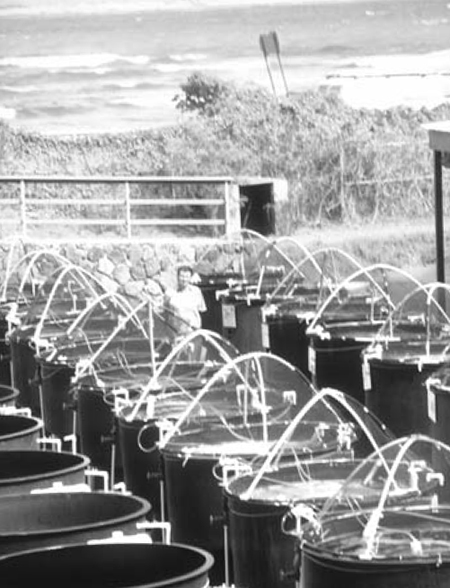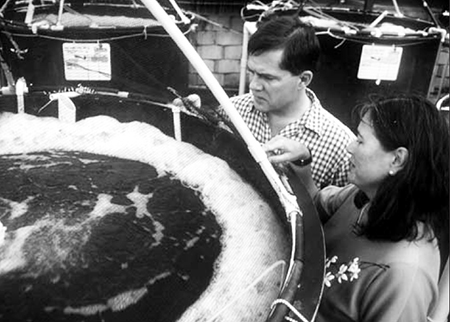Research programs and activities

In 1998 the United States had an annual trade deficit in edible and nonedible fisheries products of $6.9 billion, including $3.1 billion of imported shrimp. This trade deficit is the largest of any U.S. agricultural commodity and second only to petroleum, for any natural resources product. The expansion of domestic aquaculture production, including shrimp farming, could help offset this trade deficit. However, shrimp farming in the United States is becoming increasingly dependent upon intensification, disease prevention and control, environmental protection, product quality, cost reduction and profitability, and the use of domesticated shrimp stocks that are disease resistant and genetically improved. These requirements demand the development and use of new, improved feed processing methods, ingredients, formulations, and onfarm feed and water management practices that are not adequately provided by conventional, first-generation shrimp feeds and/or grow-out technology.
The AQUAFAN Program The main research activities of the Aquatic Feeds and Nutrition (AQUAFAN) program at The Oceanic Institute are currently related to the implementation of a five-year project (1998- 2002), entitled “Tropical Aquaculture Feeds and Culture Technology Development Project II. Development of Shrimp Feeds.” The Project is funded by the Agricultural Research Service (ARS) of the United States Department of Agriculture (USDA). Its mission is to conduct research to advance U.S. feeds technology that enhances the nutritional, environmental, and economic effectiveness of marine aquaculture. The overall goal of the project is to develop second-generation feeds technology and management for the intensive culture of high-health, genetically- improved Pacific white shrimp (Litopenaeus vannamei, formerly Penaeus vannamei) that optimizes economic returns while minimizing any possible harmful effects on the environment.
During the first year of the project, an Industry Liaison Committee (ILC) was established to provide guidance in identifying and prioritizing needs of the shrimp farming and feeds industries for improved technologies, products, and services. The ILC is composed of eight experts representing the various sectors of the aquatic feed manufacturing and shrimp farming industries, including commercial feed producers, feed equipment manufacturers, animal nutrition, commercial shrimp farms and commercial shrimp systems and economics. Working with this committee, industry needs and paths of technology transfer are kept current.
To achieve the goals of this project, OI is implementing research in the following areas:
- Nutritive requirements
- Feed nutrient flow and sinks
- Feeds and ingredient processing
- Ingredient characterization
- Feeds management
- Pond management
- Statistical, economic and production system models
Research accomplishments

The shrimp feeds project has developed Controlled Aquatic Mesocosm (CAM) Systems, which are designed to mimic advanced commercial-scale production systems using biosecurity, zero water exchange and nutrient recycling. Nutritional studies with replicate CAM systems have demonstrated the technical feasibility of using lower protein shrimp feeds, which greatly reduce cost.
Complex nutrient pathways are being tracked using stable isotope methodologies. This approach is revealing the importance of phytoplankton and bacteria for nutrient recycling within CAM systems. This information will lead to shrimp feed formulations that take into account the dietary nutrient requirements of the cultured shrimp as well as those of the living microbial community within CAM systems.
Feed processing research has investigated effects of ingredient particle size reduction, mixing, pelleting, and extrusion processing. The objective of this research is to increase feed nutrient digestibility and availability, with consequent improvements in shrimp growth and reduced feed wastage and pollution.
The OI analytical lab has developed improved techniques for the measurement of nutrients within feed ingredients and finished feeds. An analytical procedures manual for aquaculture feeds and feed ingredients was published within the revised edition of the Laboratory Methods Compendium of the American Feed Industry Association.
Project activities for 1999:
Effect of genetic selection on shrimp growth and feed efficiency, shrimp feeding behavior and the nutrient requirements of shrimp under intensive clear-water and green-water culture conditions; development of stable isotope methodologies for ascertaining and predicting the relative contribution of microorganisms to the overall nutritional budget of shrimp reared in CAM systems; use of poultry byproduct meals as replacements for marine protein in shrimp feeds; use of near-infrared spectroscopy for analysis and characterization of shrimp feed ingredient quality and concerning methodological approaches for measuring nutrient digestibility in shrimp; use of gamma irradiation for the sterilization of feed ingredients and the production of Specific Pathogen Free (SPF) shrimp feeds; evaluation of the commercial shrimp feeds produced within the U.S., including production levels and methods, physical and nutrient characteristics and cost; evaluation of the commercial on-farm feeding methods and management practices employed by shrimp farmers within the U.S.; development of predictive models that will allow simulation of shrimp biological performance and within-pond processes in outdoor zero-exchange culture systems; on-farm research, including the development of improved intensive hatchery/grow-out feed and farm management strategies for shrimp; establishment of a bibliographic database on aquatic nutrition and feed technology; and finally a project newsletter for the benefit of the research and farming community.
Alaska fisheries byproduct utilization
The Oceanic Institute is one of several collaborators in a project dealing with the production and evaluation of aquaculture and livestock feed supplements from Alaska fish processing wastes. The research goal of the project is to develop safe, environmentally sound methods to utilize fisheries waste products as alternative sources of feed ingredients for aquaculture and other farmed animals, thereby improving resource utilization and expanding economic opportunities in Alaska.
Midwest feeds consortium program
Another feeds-related program, the Midwest Feeds Consortium (MFC) was formed to provide appropriate biological and economic information on the effectiveness of grains, oilseeds, and animal co-products (e.g. whole blood meal plus corn and/or soybean meal) common to the U.S. Midwest as replacements for marine meals in aquaculture feeds. The quality, cost, and availability of marine meals are generally recognized as growing constraints worldwide.
The United States has a substantial competitive advantage in feed grain technology and production, which can be leveraged to strengthen the competitiveness of the U.S. grain and feed industry, provided that appropriate marine meal substitutes are found or developed. Work conducted by the MFC over the past four years established a basis for advancement in feeds and ingredient technology development for aquatic species, and economic assessment potential for the U.S. grain and oilseed industries. There is now evidence that indicates viable, co-product and novel ingredients can be applicable to the aquaculture feeds industry through value-added processing technologies.
Proposed pilot-scale feed mill
An Aquatic Feeds Research and Pilot Production Facility is proposed for construction on the Island of Hawaii at the Panaewa Agriculture Farm, which is operated by the University of Hawaii at Hilo. This feed mill will be a key component of the AQUAFAN program, and will conduct research activities related to pilot-scale feed processing and manufacturing. In addition to assisting with feed processing research for the AQUAFAN program, it is envisioned that the feed mill will also produce feeds for the other OI programs, undertake contracted research, and provide training, education, and consulting services.
External contracts
Currently these include: a contract with the Fishery Resources Division of the Food and Agriculture Organization of the United Nations (FAO), for the review and technical editing of a draft working paper titled, “Technical Guidelines for Good Aquaculture Feed Manufacturing Practice”; the preparation of technical guidelines in support of the FAO Code of Conduct for Responsible Fisheries, and in particular Article 9 of the Code concerning aquaculture development.
Two contracts for shrimp feeding trials were awarded by Agribrands Purina Mexico, S.A. in July 1999 and November 1999, respectively. Also a research contract by the Fats and Proteins Research Foundation Inc. in October 1999, involving the nutritional evaluation of meat and bone meal in shrimp feeds.
Aquatic feeds generally represent the largest single operating cost item (typically between 25 to 50 percent) of most intensive and semi-intensive finfish and crustacean farming operations. Consequently, ongoing AQUAFAN research and industry support activities at Oceanic Institute will play an increasingly important role in support of sustainable aquaculture worldwide.
(Editor’s Note: This article was originally published in the February 2000 print edition of the Global Aquaculture Advocate.)
Now that you've finished reading the article ...
… we hope you’ll consider supporting our mission to document the evolution of the global aquaculture industry and share our vast network of contributors’ expansive knowledge every week.
By becoming a Global Seafood Alliance member, you’re ensuring that all of the pre-competitive work we do through member benefits, resources and events can continue. Individual membership costs just $50 a year. GSA individual and corporate members receive complimentary access to a series of GOAL virtual events beginning in April. Join now.
Not a GSA member? Join us.
Author
-

Albert G.J. Tacon, Ph.D.
Aquatic Feeds and Nutrition
(AQUAFAN) Program
The Oceanic Institute
Makapuu Point
Waimanalo, Hawaii 96795 USA
Tagged With
Related Posts

Aquafeeds
Aquafeeds and The Oceanic Institute’s AQUAFAN program, part 1
OI's Aquatic Feeds and Nutrition (AQUAFAN) program aims to technically support and assist the aquaculture and aquafeed manufacturing sector.

Aquafeeds
Fishmeal, fish oil replacements in sea bream, sea bass diets need nutritional compensation
Fishmeal and fish oil replacements present a challenge for the aquafeed industry. The range of alternative protein and fat sources is limited, given multiple considerations.

Aquafeeds
The proper management of commercial shrimp feeds, part 1
Shrimp production systems and their feed management must be considered together. It requires an understanding of biological aspects of the targeted species and age, of production system used, of chemical and biological processes that control water and bottom quality and continuous system monitoring and feedback to provide appropriate and timely inputs and adjustments.

Health & Welfare
Zero exchange, aerobic, heterotrophic systems: key considerations
Most environmental concerns about aquaculture practices can be addressed effectively by zero exchange, aerobic, heterotrophic culture systems.

